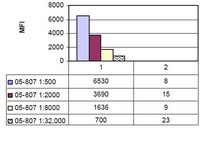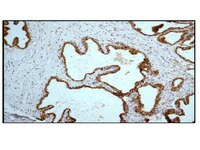CB1 receptor-mediated signaling underlies the hippocampal synaptic, learning, and memory deficits following treatment with JWH-081, a new component of spice/K2 preparations.
Basavarajappa, BS; Subbanna, S
Hippocampus
24
178-88
2014
Mostrar resumen
Recently, synthetic cannabinoids have been sprayed onto plant material, which is subsequently packaged and sold as "Spice" or "K2" to mimic the effects of marijuana. A recent report identified several synthetic additives in samples of "Spice/K2", including JWH-081, a synthetic ligand for the cannabinoid receptor 1 (CB1). The deleterious effects of JWH-081 on brain function are not known, particularly on CB1 signaling, synaptic plasticity, learning and memory. Here, we evaluated the effects of JWH-081 on pCaMKIV, pCREB, and pERK1/2 signaling events followed by long-term potentiation (LTP), hippocampal-dependent learning and memory tasks using CB1 receptor wild-type (WT) and knockout (KO) mice. Acute administration of JWH-081 impaired CaMKIV phosphorylation in a dose-dependent manner, whereas inhibition of CREB phosphorylation in CB1 receptor WT mice was observed only at higher dose of JWH-081 (1.25 mg/kg). JWH-081 at higher dose impaired CaMKIV and CREB phosphorylation in a time-dependent manner in CB1 receptor WT mice but not in KO mice and failed to alter ERK1/2 phosphorylation. In addition, SR treated or CB1 receptor KO mice have a lower pCaMKIV/CaMKIV ratio and higher pCREB/CREB ratio compared with vehicle or WT littermates. In hippocampal slices, JWH-081 impaired LTP in CB1 receptor WT but not in KO littermates. Furthermore, JWH-081 at higher dose impaired object recognition, spontaneous alternation and spatial memory on the Y-maze in CB1 receptor WT mice but not in KO mice. Collectively our findings suggest that deleterious effects of JWH-081 on hippocampal function involves CB1 receptor mediated impairments in CaMKIV and CREB phosphorylation, LTP, learning and memory in mice. | Western Blotting | 24123667
 |
Microfluidic local perfusion chambers for the visualization and manipulation of synapses.
Taylor, AM; Dieterich, DC; Ito, HT; Kim, SA; Schuman, EM
Neuron
66
57-68
2009
Mostrar resumen
The polarized nature of neurons and the size and density of synapses complicates the manipulation and visualization of cell biological processes that control synaptic function. Here we developed a microfluidic local perfusion (microLP) chamber to access and manipulate synaptic regions and presynaptic and postsynaptic compartments in vitro. This chamber directs the formation of synapses in greater than 100 parallel rows connecting separate neuron populations. A perfusion channel transects the parallel rows, allowing access with high spatial and temporal resolution to synaptic regions. We used this chamber to investigate synapse-to-nucleus signaling. Using the calcium indicator dye Fluo-4 NW, we measured changes in calcium at dendrites and somata, following local perfusion of glutamate. Exploiting the high temporal resolution of the chamber, we exposed synapses to "spaced" or "massed" application of glutamate and then examined levels of pCREB in somata. Lastly, we applied the metabotropic receptor agonist DHPG to dendrites and observed increases in Arc transcription and Arc transcript localization. | Immunocytochemistry | 20399729
 |
Calpain activation promotes BACE1 expression, amyloid precursor protein processing, and amyloid plaque formation in a transgenic mouse model of Alzheimer disease.
Liang, B; Duan, BY; Zhou, XP; Gong, JX; Luo, ZG
The Journal of biological chemistry
285
27737-44
2009
Mostrar resumen
Abnormal activation of calpain is implicated in synaptic dysfunction and participates in neuronal death in Alzheimer disease (AD) and other neurological disorders. Pharmacological inhibition of calpain has been shown to improve memory and synaptic transmission in the mouse model of AD. However, the role and mechanism of calpain in AD progression remain elusive. Here we demonstrate a role of calpain in the neuropathology in amyloid precursor protein (APP) and presenilin 1 (PS1) double-transgenic mice, an established mouse model of AD. We found that overexpression of endogenous calpain inhibitor calpastatin (CAST) under the control of the calcium/calmodulin-dependent protein kinase II promoter in APP/PS1 mice caused a remarkable decrease of amyloid plaque burdens and prevented Tau phosphorylation and the loss of synapses. Furthermore, CAST overexpression prevented the decrease in the phosphorylation of the memory-related molecules CREB and ERK in the brain of APP/PS1 mice and improved spatial learning and memory. Interestingly, treatment of cultured primary neurons with amyloid-beta (Abeta) peptides caused an increase in the level of beta-site APP-cleaving enzyme 1 (BACE1), the key enzyme responsible for APP processing and Abeta production. This effect was inhibited by CAST overexpression. Consistently, overexpression of calpain in heterologous APP expressing cells up-regulated the level of BACE1 and increased Abeta production. Finally, CAST transgene prevented the increase of BACE1 in APP/PS1 mice. Thus, calpain activation plays an important role in APP processing and plaque formation, probably by regulating the expression of BACE1. | | 20595388
 |
Context-specific modulation of cocaine-induced locomotor sensitization and ERK and CREB phosphorylation in the rat nucleus accumbens.
Marin, MT; Berkow, A; Golden, SA; Koya, E; Planeta, CS; Hope, BT
The European journal of neuroscience
30
1931-40
2009
Mostrar resumen
Learned associations are hypothesized to develop between drug effects and contextual stimuli during repeated drug administration to produce context-specific sensitization that is expressed only in the drug-associated environment and not in a non-drug-paired environment. The neuroadaptations that mediate such context-specific behavior are largely unknown. We investigated context-specific modulation of cAMP-response element-binding protein (CREB) phosphorylation and that of four upstream kinases in the nucleus accumbens that phosphorylate CREB, including extracellular signal-regulated kinase (ERK), cAMP-dependent protein kinase, calcium/calmodulin-dependent kinase (CaMK) II and CaMKIV. Rats received seven once-daily injections of cocaine or saline in one of two distinct environments outside their home cages. Seven days later, test injections of cocaine or saline were administered in either the paired or the non-paired environment. CREB and ERK phosphorylation were assessed with immunohistochemistry, and phosphorylation of the remaining kinases, as well as of CREB and ERK, was assessed by western blotting. Repeated cocaine administration produced context-specific sensitized locomotor responses accompanied by context-specific enhancement of the number of cocaine-induced phosphoCREB-immunoreactive and phosphoERK-immunoreactive nuclei in a minority of neurons. In contrast, CREB and CaMKIV phosphorylation in nucleus accumbens homogenates were decreased by cocaine test injections. We have recently shown that a small number of cocaine-activated accumbens neurons mediate the learned association between cocaine effects and the drug administration environment to produce context-specific sensitization. Context-specific phosphorylation of ERK and CREB in the present study suggests that this signal transduction pathway is selectively activated in the same set of cocaine-activated accumbens neurons that mediate this learned association. Artículo Texto completo | | 19912338
 |
A composite element that binds basic helix loop helix and basic leucine zipper transcription factors is important for gonadotropin-releasing hormone regulation of the follicle-stimulating hormone beta gene.
Ciccone, NA; Lacza, CT; Hou, MY; Gregory, SJ; Kam, KY; Xu, S; Kaiser, UB
Molecular endocrinology (Baltimore, Md.)
22
1908-23
2008
Mostrar resumen
Although FSH plays an essential role in controlling gametogenesis, the biology of FSHbeta transcription remains poorly understood, but is known to involve the complex interplay of multiple endocrine factors including GnRH. We have identified a GnRH-responsive element within the rat FSHbeta promoter containing an E-box and partial cAMP response element site that are bound by the basic helix loop helix transcription factor family members, upstream stimulating factor (USF)-1/USF-2, and the basic leucine zipper member, cAMP response element-binding protein (CREB), respectively. Expression studies with CREB, USF-1/USF-2, and activating protein-1 demonstrated that the USF transcription factors increased basal transcription, an effect not observed if the cognate binding site was mutated. Conversely, expression of a dominant negative CREB mutant or CREB knockdown attenuated induction by GnRH, whereas dominant negative Fos or USF had no effect on the GnRH response. GnRH stimulation specifically induced an increase in phosphorylated CREB occupation of the FSHbeta promoter, leading to the recruitment of CREB-binding protein to enhance gene transcription. In conclusion, a composite element bound by both USF and CREB serves to integrate signals for basal and GnRH-stimulated transcription of the rat FSHbeta gene. Artículo Texto completo | | 18550775
 |
















ethanol[841859_(4-Hydroxyphenyl)ethanol-ALL].jpg)





